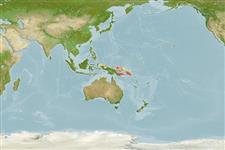>
Ovalentaria/misc (Various families in series Ovalentaria) >
Pomacentridae (Damselfishes) > Pomacentrinae
Etymology: Chrysiptera: Greek, chrysos = golden + Greek, pteron = fin, wing (Ref. 45335); cymatilis: From the Latin for sea-colored or blue, in reference to its characteristic coloration (Ref. 31117).
Environment: milieu / climate zone / depth range / distribution range
Ecologia
marinhas associadas(os) a recifes; intervalo de profundidade 3 - 20 m (Ref. 31117), usually 3 - 20 m (Ref. 41819). Tropical
Western Central Pacific: Bismarck Archipelago and Milne Bay Province of Papua
New Guinea and Solomon Is.
Tamanho / Peso / Idade
Maturity: Lm ? range ? - ? cm
Max length : 3.6 cm SL macho/indeterminado; (Ref. 31117)
Descrição suscinta
Chaves de identificação | Morfologia | Morfometria
Espinhos dorsais (total) : 13; Raios dorsais (total) : 10 - 11; Espinhos anais: 2; Raios anais : 10 - 12. Tubed lateral line scales 11-14; brilliant deep blue with lighter blue ocellus-like markings on head and breast, and black spot or blotch at base of posterior dorsal rays; caudal fin emarginate (Ref. 31117). Body depth 1.9-2.2 in SL (Ref. 90102).
Adults are found in sheltered seaward coral reefs and lagoons (Ref. 31117), in aggregations within Acropora sp. and Seriatopora histrix (Ref. 41819). Presumably feeding on zooplankton (Ref. 31117). Oviparous, distinct pairing during breeding (Ref. 205). Eggs are demersal and adhere to the substrate (Ref. 205). Males guard and aerate the eggs (Ref. 205). Diurnal species (Ref. 52881).
Ciclo de vida ou comportamento de acasalamento
Maturities | Reprodução | Spawnings | Egg(s) | Fecundities | Larvas
Oviparous, distinct pairing during breeding (Ref. 205). Eggs are demersal and adhere to the substrate (Ref. 205). Males guard and aerate the eggs (Ref. 205).
Hunnam, P., A. Jenkins, N. Kile and P. Shearman, 2001. Bismarck-Solomon Seas Ecoregion: Papua New Guinea Solomon Islands. p. 86. In Mangubhai, S., B. Masianini, D. Gorman and A. Jenkins (eds). Marine Resource Management and Conservation Planning. (Ref. 41819)
Status na Lista Vermelha da UICN (Ref. 130435)
Ameaça para os humanos
Harmless
Uso pelos humanos
Ferramentas
Relatórios especiais
Baixar XML
Fontes da internet
Estimates based on models
Preferred temperature (Ref.
123201): 27.3 - 29.1, mean 27.8 °C (based on 10 cells).
Índice de diversidade filogenética (Ref.
82804): PD
50 = 0.5000 [Uniqueness, from 0.5 = low to 2.0 = high].
Bayesian length-weight: a=0.01000 (0.00244 - 0.04107), b=3.04 (2.81 - 3.27), in cm total length, based on all LWR estimates for this body shape (Ref.
93245).
Nível Trófico (Ref.
69278): 3.4 ±0.45 se; based on food items.
Resiliência (Ref.
120179): Elevada, tempo mínimo de duplicação da população menor que 15 meses (Preliminary K or Fecundity.).
Fishing Vulnerability (Ref.
59153): Low vulnerability (10 of 100).
